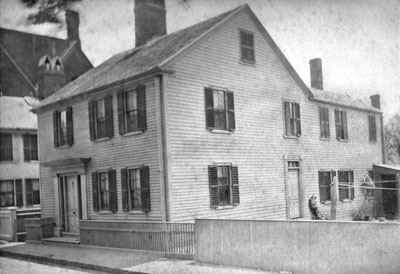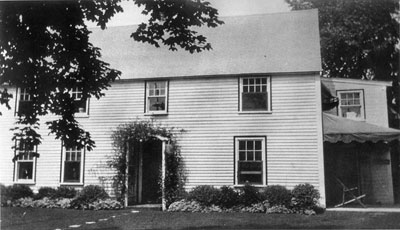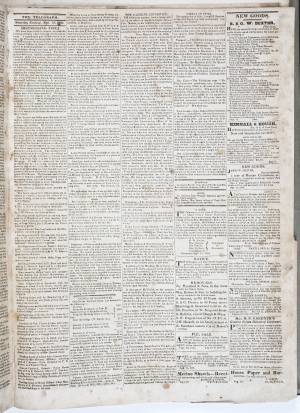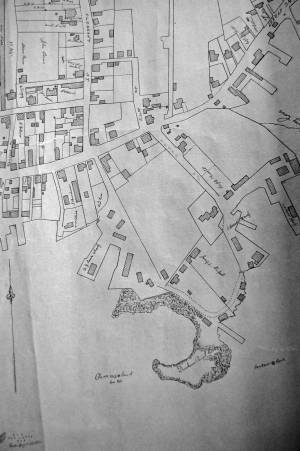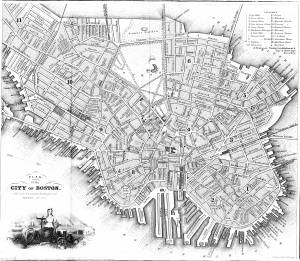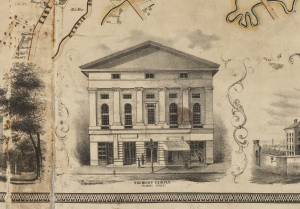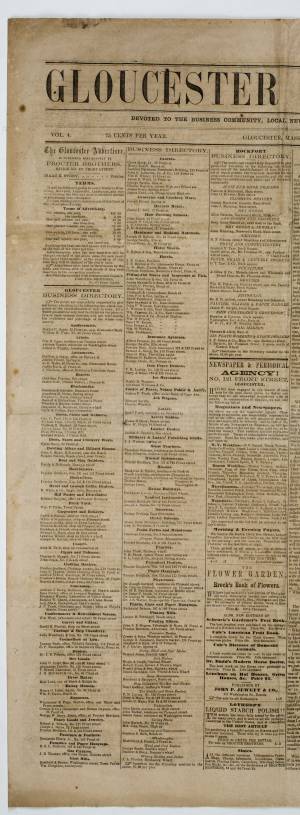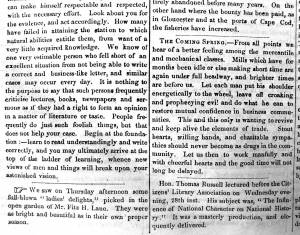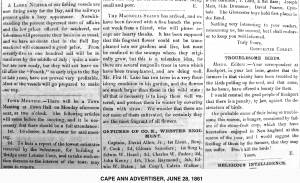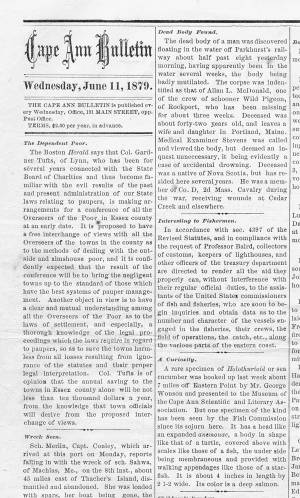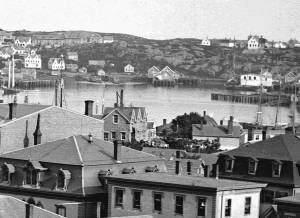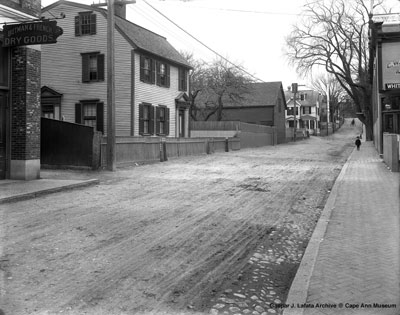An online project under the direction of the CAPE ANN MUSEUM
Residences
View related Fitz Henry Lane catalog entries (2) »
The Lane family was living at what is now 85 Middle Street, Gloucester, Massachusetts when Nathaniel Rogers Lane was born on December 19, 1804, and he continued to reside there until he moved to Boston, as Fitz Henry Lane, around 1832. This house is now gone, replaced by the brick building of the old Gloucester Cooperative Bank. Also in the house had been his father Jonathan Dennison Lane, a sail-maker, who died in 1816; his mother Sarah Haskell Lane and his older brother Edward who lived there until 1839; and his younger sister Sarah Ann Lane who lived there until she married Ignatius Winter in 1834 and moved to Boston.
Fitz Henry's residence in Boston lasted from the early 1830s until his return to Gloucester in 1849, but his home addresses are not established. He had studios at various locations—7 Summer Street, 17 School Street, 16 Tremont Temple, and 28 Joy's Building at 77–85 Washington Street. It is possible that he lived with his sister and her husband and their growing family near Haymarket Square, mostly on the now-lost Friend Street. Ron Polito has established his studio in room 16 of Tremont Temple for the years 1843 to 1850.
When Lane visited Gloucester while living in Boston, he stayed at his family's house on Middle Street until 1839, and then at his mother and brother's house at 179 Washington Street, near the entrance to the Oak Grove Cemetery. He also had a studio on Elm Street, where now a parking lot lies behind the Cape Ann Museum. This accommodation lasted until the stone house on Ivy Court, Duncan's Point, was completed in 1851 and he and the large Winter family moved into it. Fitz Henry lived in the Stone House for the rest of his life. His sister Sarah, her husband Ignatius Winter, and their seven surviving children, lived there also until they were evicted by a bit of legal and real-estate dealing by Lane's friend Joseph L. Stevens. After that, Lane lived in peace with a housekeeper, probably his cousin Mrs. Elizabeth Haskell Galacar and her daughter Allie, from 1862 until August 13, 1865, when he died.
– Sarah Dunlap (June, 2015)
Related tables: Lane's Stone House, Duncan's Point » // Tremont Temple »
85 Middle Street is Lane's birthplace. In Lane's day the house wouldn't have had the extension in the back.
Also filed under: Chronology »
Also filed under: Chronology »
Ivy Court was the name of the street where Lane built his stone house. "A path that became known as Ivy Court ran up the hill to the southeast from Locust Street. Lane built his stone house on top of the hill, along the southwest side of Ivy Court . . ."
From Buck and Dunlop, Fitz Henry Lane: Family and Friends, p. 152.
Also filed under: Chronology » // Lane's Stone House, Duncan's Point »
Newspaper
"Distressing Fire" col. 1
Gloucester Telegraph
American Antiquarian Society
A great fire swept through Main St. in Gloucester:
“We have been called to witness the most distressing calamity which has ever visited our citizens. A considerable part of our town is in ruins. On Thursday morning, about 4 o’clock fire was discovered in the house owned and occupied by Samuel Gilbert, in Front Street, and is supposed to have commenced in a building in rear of said house, though the exact spot in which it originated is not accurately known, The flames spread with such rapidity, notwithstanding the calmness of the atmosphere, that no effectual check could be given, until they had destroyed upwards of 20 dwelling houses, together with about 40 stores, mechanic’s shops and other smaller buildings. These were mostly on the south side of the street, and between it and the water. Crossing the street, however, it destroyed several buildings, but was fortunately arrested at the store of Kimball & Hough, by demolishing two small buildings adjoining. It was finally checked by the arrival of assistance from Sandy Bay, Essex, Manchester and Ipswich, the engines from those places rendering the most important services, as without them the greater part of the village must have been consumed. We feel very grateful to the citizens of the above named places as well as to those of Salem, Beverly, Danvers & Marblehead. They set out very promptly at the first information of our distress, but in consequence of the general confusion & anxiety that prevailed, suitable measures were not taken to obtain seasonable aid from the most distant of these towns.
The disaster has fallen upon that part of our town in which the most business was transacted, and the sufferers are among our most active and enterprising citizens. No correct estimate of the losses sustained can, at present be made. – Great praise is due to the citizens generally for their intrepidity and vigorous exertions on this occasion . . . “
Lane was not mentioned by name, but he would have removed his furniture along with others.
Also filed under: Biographical information » // Chronology » // Newspaper / Journal Articles »
Lithograph
24 x 38 in.
Gloucester City Archives
"Drawn on a scale of one hundred feet to an inch. By John Mason 1834–45 from Actual Survey showing every Lott and building then standing on them giving the actual size of the buildings and width of the streets from the Canal to the head of the Harbour & part of Eastern point as farr as Smith's Cove and the Shore of the same with all the wharfs then in use. Gloucester Harbor 1834–35."
This map shows the location of F. E. Low's wharf and the ropewalk. Duncan's Point, the site where Lane would eventually build his studio, is also marked.
The later notes on the map are believed to be by Mason.
Also filed under: Duncan's Point » // Gloucester Harbor, Inner / Harbor Cove » // Low (Frederick G.) wharves » // Low, Capt. Frederick Gilman » // Maps » // Mason, John » // Ropewalk » // Somes, Capt. John »
9 x 14 in.
Cape Ann Museum Library & Archive
Showing Lane's neighborhood while working in Boston. Lane had studios at the intersection of Washington and State Streets, Summer, Tremont and School Streets.
Also filed under: Boston City Views » // Lane & Scott's, Lith. – Boston » // Maps » // Professional » // Tremont Temple »
Map insert to Boston Almanac and Directory
Cape Ann Museum Library & Archive
Also filed under: Boston City Views » // Maps » // Tremont Temple »
Boston
Boston Public Library: Norman B. Leventhal Map Center
Call Number: G3764.B6 1852.M35
Also filed under: Boston City Views » // Maps »
Boston
Norman B. Leventhal Map Center at Boston Public Library
Call Number: G3764.B6 1852.M35
Lane's studio was in the vicinity of the Tremont Temple
Also filed under: Tremont Temple »
Newspaper
"Letters on Art. - No. IV"
"In that space [four years] the town has grown greatly . . . a great ugly, yellow "Pavilion" suns itself on the rocks . . . I said there are only two stone buildings in this town of Gloucester: one is "the Bank," the other belongs to Mr. F. H. Lane, whose name ought to be known from Maine to Georgia as the best marine painter in the country.
If Mr. Lane is not as well known as he ought to be, he has at least no reason to complain of neglect or want of appreciation. He has been painting only fifteen years, and his pictures are in great demand; hitherto chiefly among sea-faring men, but now winning way in other circles. In former times I used to be often in Mr. Lane's painting-room, and it was with real pleasure that I found my way to his new house, built from his own design, of native granite, as I mentioned, handsome, peculiar, stable, and commanding a wide sweep of land and ocean from its ample windows. The house is the best that has been built in Gloucester for fifty years. . .
Mr. Lane has put few pictures in his studio at present; for he is very industrious, and sends his canvases off as fast as they are filled. If you were to meet him in the street, you would hardly take him for an artist. A man apparently of forty years, walking with difficulty, supported by crutches, hard-handed, browned by the sun and exposure, with a nose indicating less the artist sensibility than the artist resolution . . .
His early pictures had something in them too hard and practical to permit enthusiastic admiration; the water was salt, the ships sailed, the waves moved, but it was the sea before the Spirit of God moved upon the face of the deep.
His pictures early delighted sailors by their perfect truth. Lane knows the name and place of every rope on a vessel; he knows the construction, the anatomy, the expression – and to a seaman every thing that sails has expression and individuality . . . [Lane] has earned his money thus far mostly by painting "portraits" of vessels for sailors and ship-owners. It is owing to this necessity, perhaps, that he has fallen into the fault of too great literalness of treatment, which I have mentioned as characterizing some of his earlier works; but with the rapid advance he has made in the past four years, there is no longer any fear that he is incapable of treating a subject with genuine imagination . . .
He has indulged in no tricks and no vagaries; he has slighted nothing, despised nothing. If I appear to think less of his early pictures than they deserve, it is not because they are carefully even painfully studied, and because no detail has escaped his eye or brush; it is not that he has too much conscience; but simply because I missed in them the creative imagination of the artist. But it may well be a question whether at this day, when slight and untruthful work prevails, when artists will not paint with conscience, and the public does not strenuously demand it, conscience and love are not higher needs than imagination, and whether Mr. Lane's early pictures, the landmarks on his toilsome, earnest journey to his present place, have not a great value of their own. There is not one of them that I have seen, without some valuable passage, showing acute observation and careful, studious execution.
A sea-piece, "Off the coast of Maine, with Desert-Island in the distance," is the finest picture that Mr. Lane has yet painted. The time is sunset after a storm. The dun and purple clouds roll away to the south-west, the sun sinks in a glory of yellow light, flooding the sea with transparent splendor. Far away in the offing, hiding the sun, sails a brig fully rigged . . . I urged Mr. Lane to send this picture to New-York for exhibition . . ."
Also filed under: Newspaper / Journal Articles » // Pavilion Hotel »
Newspaper
"Business Directory Listings"
Artists – Fitz H. Lane, residence on Duncan Street
Addison Center, residence on Washington St.
Also filed under: Center, Addison » // Newspaper / Journal Articles »
"Mr. Fitz H. Lane informs us that he counted on one strawberry plant in his garden, 205 berries. He had several plants which bore 150. We have not heard of any one's going ahead of this – If it has been eclipsed we would like to publish it."
Also filed under: Chronology » // Newspaper / Journal Articles »
Newsprint
Courtesy of the American Antiquarian Society, Worcester, Mass.
See p. 1, columns 1 and 2.
"Artists. / Fitz H. Lane, residence on Duncan street. / Addison Center, residence on Washington street. / Alfred J. Wiggin, Annisquam."
Also filed under: Newspaper / Journal Articles » // Procter Brothers » // Professional » // Winter, Ignatius »
"We saw on Thursday afternoon some full-blown 'ladies' delights,' picked in the open garden of Mr. Fitz H. Lane. they were as bright and beautiful as in their own proper season."
Also filed under: Chronology » // Newspaper / Journal Articles »
Newsprint
Cape Ann Advertiser
Collection of Fred and Stephanie Buck
About the two magnolia trees in his garden:
"THE MAGNOLIA SEASON has arrived, and we have been favored with a fine bunch the present week from a friend, who will please accept our hearty thanks. It has been supposed that this fragrant flower could not be transplanted into our gardens and live, but must be confined to the swamps where they originally grow, but this is a mistaken idea, for there are several magnolia trees in town which have been transplanted, and are dowing well. Mr. Fitz H. Lane has two trees in a very flourishing condition in his garden, and the flowers are much larger than those in the wild state; all that is necessary is to keep them well watered, and protect them in winter by covering them with straw. We wonder that there are not more of them cultivated, for certainly they are the most fragrant of all flowers."
Also filed under: Chronology » // Newspaper / Journal Articles »
Newspaper
Cape Ann Bulletin
Advertisement for the late Fitz H. Lane's house
Cape Ann Museum Library & Archives
Desirable Residence For Sale.
The stone cottage house, on Ivy Hill, Gloucester, built by the late Fitz H. Lane, marine artist, and lately occupied by Capt. F.G. Low, deceased, is to be sold. It commands a fine view of the harbor and city, has a large lot of land well stocked with fruit and ornamental trees and shrubs, and is very near Post Office and Railroad Station, making it a desirable summer or permanent residence. For particulars apply to David W. Low, Gloucester, Mass.
Four-page letter
Collection of the Cape Ann Museum Library & Archive, Gloucester, Mass.
"[The painting] is offered you for $150 on as long time and in as many notes at 3% interest as you choose. . . I believe this to be the only important painting of Gloucester Harbor that Lane never duplicated. . . .Returning from a Gloucester visit while I was still under the roof there, father brought a print of Lane's first Gloucester view, bought of the artist at his Tremont Temple studio in Boston. An extra dollar had been paid for coloring it. For a few years it was a home delight.. . .I had been a few years in Gloucester when Lane began to come, for part of the time a while, if I remember rightly. He painted in his brother's house, "up in town" it then was. I recall visits there to see his pictures. But it was long after, that I could claim more than a simple speaking acquaintance. The Stacys were very kind, aiding him as time went on in selling paintings by lot. I invested in a view of Gloucester from Rocky Neck, thus put on sale at the old reading room, irreverently called "Wisdom Hall." And they bought direct of him to some extent, before other residents. Lane was much my senior and yet we gradually drifted together. Our earliest approach to friendship was after his abode began in Elm Street as an occupant of the old Prentiss [sic-corrected Stacy] house, moved there from Pleasant. I was a frequenter of this studio to a considerable extent, yet little compared with my intimacy at the next and last in the new stone house on the hill. Lane's art books and magazines were always at my service and a great inspiration and delight—notably the London Art Journal to which he long subscribed. I have here a little story to tell you. A Castine man came to Gloucester on business that brought the passing of $60 through my hands at 2 1/2 % commission. I bought with the $1.50 thus earned Ruskin's Modern Painters, my first purchase of an artbook. I dare say no other copy was then owned in town. . . .Lane was frequently in Boston, his sales agent being Balch who was at the head of his guild in those days. So in my Boston visits – I was led to Balch's fairly often – the resort of many artists and the depot of their works. Thus through, Lane in various ways I was long in touch with the art world, not only of New England but of New York and Philadelphia. I knew of most picture exhibits and saw many. The coming of the Dusseldorf Gallery to Boston was an event to fix itself in one's memory for all time. What talks of all these things Lane and I had in his studio and by my fireside!
For a long series of years I knew nearly every painting he made. I was with him on several trips to the Maine coast where he did much sketching, and sometimes was was [sic] his chooser of spots and bearer of materials when he sketched in the home neighborhood. Thus there are many paintings whose growth I saw both from brush and pencil. For his physical infirmity prevented his becoming an out-door colorist."
Glass plate negative
Cape Ann Museum Library & Archive
Detail from CAHA#00279
The magnificent views of Gloucester Harbor and the islands from the top floor of the stone house at Duncan's Point where Lane had his studio were the inspiration for many of his paintings.
From Buck and Dunlop, Fitz Henry Lane: Family, and Friends, pp. 59–74.
Also filed under: Duncan's Point » // Gloucester Harbor, Inner / Harbor Cove » // Lane's Stone House, Duncan's Point »
Elm Street looking toward Prospect Street 1897. Gambrel moved from 17 Pleasant Street in 1842 by Harvey Coffin McKay to build his new house. F. H. Lane lived and worked in this Gambrel at 8 Elm Street with his sister and brother-in-law for several years until the stone house on Duncan Street was built in 1850. See Stephanie Buck,Fitz Henry Lane, Family and Friends, p. 51.
